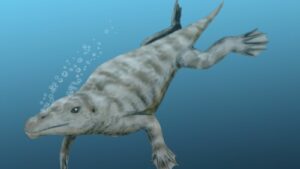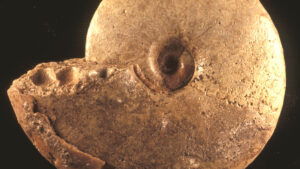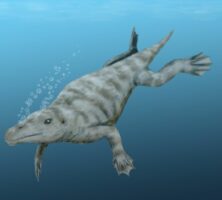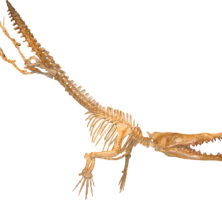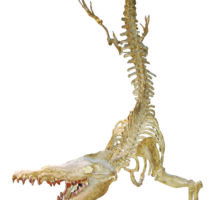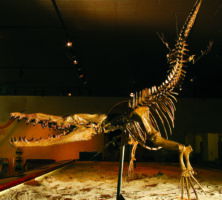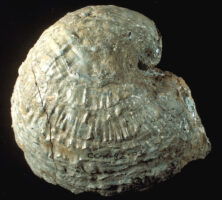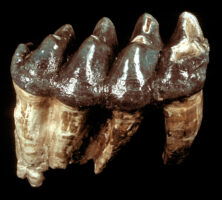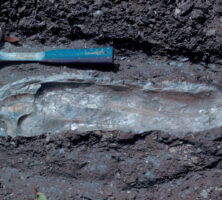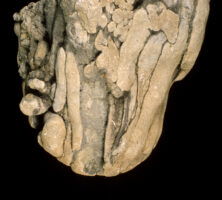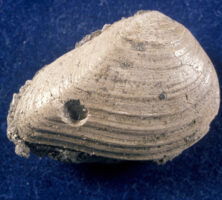The New Georgia Encyclopedia is supported by funding from A More Perfect Union, a special initiative of the National Endowment for the Humanities.
Though scientists long believed that proto-whales may have been amphibious, the discovery of a nearly complete Georgiacetus skeleton by researchers at Georgia Southern University suggests that it was fully marine as depicted in this artist's rendering.
Photograph by Nobu Tamura
The New Georgia Encyclopedia does not hold the copyright for this media resource and can neither grant nor deny permission to republish or reproduce the image online or in print. All requests for permission to publish or reproduce the resource must be submitted to the rights holder.
Three individual Georgiacetus whales were unearthed from 40-million-year-old sediments during the construction of Plant Vogtle. Researchers named the fossils Goergiacetus vogtlensis, meaning "Georgia Whale from Plant Vogtle."
Courtesy of Georgia Southern University Museum
The New Georgia Encyclopedia does not hold the copyright for this media resource and can neither grant nor deny permission to republish or reproduce the image online or in print. All requests for permission to publish or reproduce the resource must be submitted to the rights holder.
The living Georgiacetus whale was estimated to be eleven feet long, based on the skull, which was itself about thirty inches long.
Courtesy Georgia Southern University Museum
The New Georgia Encyclopedia does not hold the copyright for this media resource and can neither grant nor deny permission to republish or reproduce the image online or in print. All requests for permission to publish or reproduce the resource must be submitted to the rights holder.
The Georgiacetus whale, an early ancestor of the modern whale, lived in the shallow sea that covered Georgia during the Eocene epoch (of the Paleogene period). The whale's hind legs and hips were functional.
Photograph by Pamela J. W. Gore
The New Georgia Encyclopedia does not hold the copyright for this media resource and can neither grant nor deny permission to republish or reproduce the image online or in print. All requests for permission to publish or reproduce the resource must be submitted to the rights holder.
A reconstruction of Georgiacetus can be seen at the Georgia Southern University Museum in Statesboro. Georgia Southern researchers discovered and recovered a Georgiacetus skeleton in the mid-1980s.
Courtesy of Georgia Southern University Museum
The New Georgia Encyclopedia does not hold the copyright for this media resource and can neither grant nor deny permission to republish or reproduce the image online or in print. All requests for permission to publish or reproduce the resource must be submitted to the rights holder.
Ammonites, now extinct, were a type of cephalopod found in the Coastal Plain during the Late Cretaceous. This specimen of Placenticeras benningi measures 10 centimeters in diameter and was found at the Eutaw Formation in Chattahoochee County.
Photograph by David R. Schwimmer
The New Georgia Encyclopedia does not hold the copyright for this media resource and can neither grant nor deny permission to republish or reproduce the image online or in print. All requests for permission to publish or reproduce the resource must be submitted to the rights holder.
The state fossil of Georgia is the tooth of Carcharocles megalodon, a large shark that became extinct at the end of the Pliocene period. The pictured specimen, which dates to the Late Miocene, was found near Savannah and measures 11 centimeters.
Photograph by David R. Schwimmer
The New Georgia Encyclopedia does not hold the copyright for this media resource and can neither grant nor deny permission to republish or reproduce the image online or in print. All requests for permission to publish or reproduce the resource must be submitted to the rights holder.
This specimen of Exogyra erraticostata, an oyster common during the Late Cretaceous period on Georgia's Coastal Plain, was found at the Blufftown Formation in Stewart County. It measures approximately 12 centimeters.
Photograph by David R. Schwimmer
The New Georgia Encyclopedia does not hold the copyright for this media resource and can neither grant nor deny permission to republish or reproduce the image online or in print. All requests for permission to publish or reproduce the resource must be submitted to the rights holder.
This composite reconstruction of a skull of Deinosuchus rugosus, a giant crocodylian found on the Coastal Plain of Georgia during the Late Cretaceous, measures 1.1 meters. The crocodylians were larger than the carnivorous dinosaurs found along the coast and are believed to have been the top predators in the region around 82 to 75 million years ago.
From King of the Crocodylians, by D. R. Schwimmer. Reproduced by permission of David R. Schwimmer
The New Georgia Encyclopedia does not hold the copyright for this media resource and can neither grant nor deny permission to republish or reproduce the image online or in print. All requests for permission to publish or reproduce the resource must be submitted to the rights holder.
This molar tooth of the mastodon Mammut americanum, with a crown length of 14 centimeters, was found in Stewart County. Both mastodons and mammoths roamed the Coastal Plain during the Ice Age.
Photograph by David R. Schwimmer
The New Georgia Encyclopedia does not hold the copyright for this media resource and can neither grant nor deny permission to republish or reproduce the image online or in print. All requests for permission to publish or reproduce the resource must be submitted to the rights holder.
The Late Cretaceous oyster, Crassostrea cusseta, pictured alongside a hammer measuring 33 centimeters in length, could grow to 60 centimeters. This specimen was found at the Blufftown Formation in Stewart County.
Photograph by David R. Schwimmer
The New Georgia Encyclopedia does not hold the copyright for this media resource and can neither grant nor deny permission to republish or reproduce the image online or in print. All requests for permission to publish or reproduce the resource must be submitted to the rights holder.
This specimen of Late Cretaceous wood, preserved as lignite, was found at the Eutaw Formation in Chattahoochee County. The wood contains holes that were bored by clams, or "shipworms."
Photograph by David R. Schwimmer
The New Georgia Encyclopedia does not hold the copyright for this media resource and can neither grant nor deny permission to republish or reproduce the image online or in print. All requests for permission to publish or reproduce the resource must be submitted to the rights holder.
This fossil of a Late Cretaceous clam, Crassatellites roodensis, features a hole bored by a type of snail known as a naticid. Such holes were a cause of mortality for many clam species during this period.
Photograph by David R. Schwimmer
The New Georgia Encyclopedia does not hold the copyright for this media resource and can neither grant nor deny permission to republish or reproduce the image online or in print. All requests for permission to publish or reproduce the resource must be submitted to the rights holder.
Fossilized crab burrows on Cumberland Island were formed in sand deposits during the Pleistocene. Such burrows are found throughout the barrier islands and are typically about one meter deep.
Photograph by David R. Schwimmer
The New Georgia Encyclopedia does not hold the copyright for this media resource and can neither grant nor deny permission to republish or reproduce the image online or in print. All requests for permission to publish or reproduce the resource must be submitted to the rights holder.
